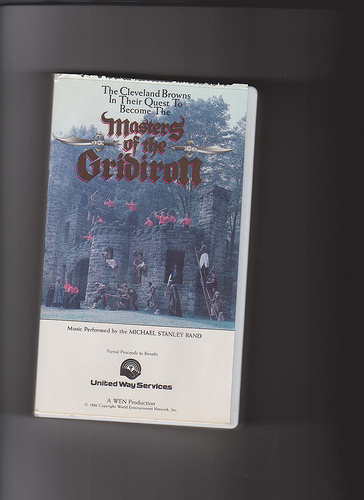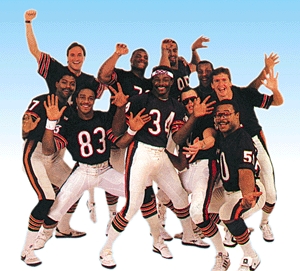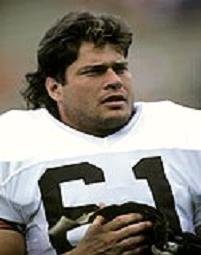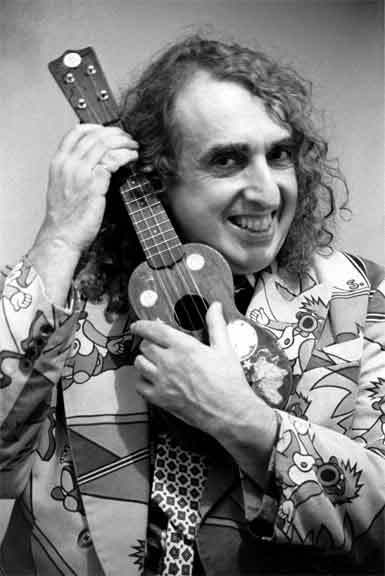 Browns Archive
Browns Archive  Masters of the Gridiron: 25 Years Later
Masters of the Gridiron: 25 Years Later

Just after Christmas in 1986, I walked into a Cleveland record store and quickly scanned every square inch with my wide, 10-year-old eyes.
Not finding what I sought, and too shy to inquire myself, I had my father ask the hairy guy behind the counter if they had it.
The cashier, who smelled like a burning mattress, shrugged casually. “Nope,” he replied in the gravelly voice required of someone who worked at a 1980s record store. “All out.”
Heartbroken, I slouched back out into the inky winter night, having to remain contented with what I’d already received for Christmas.
Yet in that moment, feverish with love for the 12-4 division-champion Cleveland Browns, everything else Santa had scored for me was nonsense. There was only one thing that could have made that Christmas complete, and, dammit to hell, I couldn’t find it anywhere.
I wanted...no...I needed Masters of the Gridiron.
Like the Shuffle, Only Different
If you’re familiar with Masters of the Gridiron, you likely have a story much like this and can understand how it was capable of either making or breaking that Christmas of 1986, whether you were 10 years old or 50.
If you’re not familiar with Masters of the Gridiron...oh, my. Where to begin?
How can one possibly describe something that brought together He-Man, Tiny Tim, Mike Pagel, the Michael Stanley Band, and a live bear?
I suppose you’d have to start out the way many stammering fathers uncomfortably begin telling their sons about sex:
“You see, when fans love their football team very much, sometimes the football team will get together and create something so delightfully random and silly that it will make the fans’ hearts swell with pride.”
Even if you don’t know about Masters of the Gridiron, you’ve certainly heard of the “Super Bowl Shuffle.” Tragically, we all have.
In late 1985, as the Chicago Bears were wrapping up a rhapsodic regular season in which they simply disemboweled opponents with a colorful cast of characters that even today remain household names, they whipped up a quasi-rap tune with a $59 Casio keyboard and created a music video with the production quality of an episode of Lawrence Welk, primarily starring colossal white guys in football uniforms trying to dance. Then, as if it were a biological weapon, they released it upon the public.
It was ugly, arrogant, obnoxious, and embarrassing. So naturally, this being the 1980s, America loved it.
It added to the Bears’ growing legend, and when they steamrolled to a world title a month later, they - and the “Super Bowl Shuffle” - were forever etched in sports history.
Masters of the Gridiron was kind of like that - except for the part about it being a national sensation. And the shuffling. And, come to think of it, the Super Bowl.
While it did have a song - and a halfway decent one at that - it also had a story, not unlike Michael Jackson’s “Thriller,” which reinvented the genre of the music video a couple of years earlier.
But instead of featuring the King of Pop, Masters of the Gridiron centered on a center.
The Baabarian
Mike Baab wound up having a very respectable 11-year career in the NFL, highlighted by two tours of duty with the Browns. He was an underrated member of the team, essentially becoming the glue that held the offensive line together.
But for all that, Masters of the Gridiron is probably what he’s best remembered for.
It all started with his penchant for Conan the Barbarian comic books, a passion he picked up waiting for a haircut one day when he was a student at the University of Texas.
of Texas.
After he’d been a mainstay with the Browns for a few years and the Cleveland Stadium bleachers began to resemble a rough draft of a Salvador Dali painting, a group of fans labeled themselves “Baab’s Barbarians” and began dressing up like medieval warriors and cheering Baab on during games.
And Baab himself - who would often acknowledge the fans by pretending to draw an imaginary sword on the field and pointing it at them - was labeled with the fabulous nickname “Baabarian.”
Thus, in the aftermath of the “Super Bowl Shuffle” and “Thriller,” these elements just begged to be developed into a made-for-charity video. So Baab, with his wife serving as producer, was thrust to the forefront as a thespian.
But it wasn’t just about the Baabarian.
A dozen players participated, likely in exchange for free ribs from Tony Roma’s. And with their boundless theatrical enthusiasm, stoked by barbeque sauce, the narrative effortlessly came to life.
And Now, Our Story...
We begin in the Browns’ locker room as the players prepare for a game then take the field, and we’re treated to actual sideline footage of the Browns’ 1986 victory over Detroit. In a fictional sidebar, Mike Baab is knocked unconscious and his teammates gather around him to see if he’s all right.
At the command of a cloaked figure who may or may not be George Voinovich, Baab awakens as the Baabarian - topless and covered with charcoal stains - and is sent on a journey that will “test all of his warrior skills.”
Curious, the Baabarian responds with perhaps the greatest line of dialogue ever written: “What is this great journey you seek to send me on, oh ruler of the city by the lake called Erie?”
(Diagram that sentence. I dare you.)
The cloaked figure explains that the Baabarian is being sent in search of a great ring, which is now in the possession of the mysterious Lord of the League. Once the Baabarian is victorious, the figure explains, the city by the lake called Erie would be home to the Masters of the Gridiron.
So, by standing on a rock and blowing into a beer bong, the Baabarian calls forth his fellow warriors - the, ahem, “clan of Modella” - to help him.
And this is the point at which Masters of the Gridiron starts cooking with gas.
His companions come from across the land - from the Planes of Passrushan and the Hills of Linebacka to the Mines of Offencia and the Hamlet of Interceptus.
Among them are Golican (Bob Golic), Hairstone (Carl Hairston), Clayrock (Clay Matthews), Mackmaulus (Kevin Mack), and Bynthor (Earnest Byner - whose name is actually misspelled in the credits).
They gather before the Baabarian, ready for their epic quest - each wearing whitewashed Cookie Monster slippers and a bathmat around his waist.
They arrive at the palace (in fact Squire’s Castle in Willoughby Hills) of the Lord of the League (the ukelele-toting Tiny Tim) and are suddenly under attack from his minions (a dozen doughy sushi chefs with plastic swords.) And somebody wrestles a bear, which suddenly appears out of nowhere and perhaps, considering what we now know about Ohioans’ bizarre passion for exotic animals, may not have been scripted.
minions (a dozen doughy sushi chefs with plastic swords.) And somebody wrestles a bear, which suddenly appears out of nowhere and perhaps, considering what we now know about Ohioans’ bizarre passion for exotic animals, may not have been scripted.
The climactic fight and the centerpiece musical anthem begin, inter-spliced with shots of Michael Stanley in a trenchcoat singing at barren Cleveland Stadium in a sequence that drips pure MTV ’80s cheese. As the Baabarian and his compatriots roll around in the leaves and toss sushi chefs around like Cabbage Patch Kids, Michael Stanley belts out the rock epic “Hard Die the Heroes,” which is now available on iTunes. (No shit - it really is. Seriously.)
Their foes vanquished and Michael Stanley back at PM Magazine, the Baabarian pursues Tiny Tim deeper into the Metropark for the thick, meaty conclusion to our tale. Inside the castle, he must face the ultimate challenge - a slightly bigger sushi chef who is dispatched in just under 16 seconds. The Baabarian then takes the ring and slips it on his gnarled finger.
But, with his greasy perm shimmering in the torchlight, the nefarious Tiny Tim knocks out the Baabarian from behind and Mike Baab awakens on the field at the Stadium with his teammates looking down at him. But of course, he’s still dressed as the Baabarian. And he’s wearing the magical ring.
The credits, which make up 25% of the duration of the video, then roll. And our lives are changed forever.
Serendipitous Destiny
Masters of the Gridiron premiered 25 years ago this week. There was a debut celebration at the Beach Club in the Flats, and then it went on sale to the public: $19.95 for the VHS tape, a 45 RPM record of “Hard Die the Heroes” for $1.99, and special promotional posters for $3.50.
Seven days after the debut, the real-life Browns lit up the Miami Dolphins on Monday Night Football and we were off to the races in one of the greatest seasons in Browns history.
The timing of the release couldn’t have been better. The Browns won eight of their last nine games, roared to the division title, and secured home-field advantage throughout the playoffs. With each passing week, the storyline of Masters of the Gridiron seemed less and less silly. (Except for the random wrestling bear.) The real-life Browns truly seemed to be on an epic quest to become the overlords of their domain.
Now, keep in mind that Masters of the Gridiron was filmed before the 1986 season began. The timing (and perhaps the cinematography) suggested that it was whipped out over a weekend once the Browns got hot, a la the “Super Bowl Shuffle.” But it was much more plotted and took much more planning and preparation than the Chicago Bears’ lackadaisical indictment against music itself the year before.
The Browns were coming off an 8-8 - albeit playoff - season. And while the fan base was as loyal as ever, there was no palpable excitement over the team when the idea for Masters of the Gridiron was conceived. (Likely after more than a few cans of Pabst Blue Ribbon.)
There was no way of knowing that the team was going to take off literally the same week the video came out. It was serendipity so pure as to be patently unbelievable.
Or was it?
Is it possible that the knuckleheaded, good-hearted goofiness of Masters of the Gridiron is what launched the ’86 Browns toward their destiny?
Through November and December, the videos and 45s of Masters of the Gridiron flew off the shelves, thus, by the week after Christmas, my search for a copy at the record store with the hairy galoot behind the counter proved fruitless.
Today Masters of the Gridiron is carefully packed away in the proverbial treasure chest with our other memories of the Browns’ pixie-dust-coated 1986 season and remains a fossil from a bygone era in the team’s longstanding relationship with its fans.
You can’t, for example, picture any current NFL team’s seven-tiered PR department allowing something like this to happen today. Nor would any agent permit his client to participate in something so delightfully whimsical that it could potentially reveal the presence of a human soul beneath all the tattoos and bling. To do so would be the equivalent of playing a game with strep throat - and we’ve seen how horrifying that concept can be.
But, as we’re reminded each time the current Browns take the field for another delightful afternoon of three-yard passes and offsides penalties, this clearly isn’t 1986.
And it’s the antiquated flavor of the entire thing that makes Masters of the Gridiron so precious. It’s like watching fuzzy home movies from an old birthday party. Everybody’s hair is both longer and weirder and you can’t believe you actually wore that in public, but as you watch you can feel warm nostalgia slipping around you and drawing you into a much-needed embrace.
It may not have garnered much attention outside of the 216 area code, but it’s something we’ll never forget.
As Michael Stanley sang 25 years ago, heroes die hard.
So too do our fond memories of Masters of the Gridiron.
This is the sixth in a series of articles about the amazing Cleveland sports calendar year of 1986.
- NBA Announces 2013-2014 Schedule
- Browns Ink Sharknado
- Sharknado A No-Show For Rookie Camp
- Trent Richardson Out Until Training Camp
- Browns Sign Brandon Jackson
- Carrasco Suspended Eight Games
- Browns Add to Wide Receiver Depth with David Nelson
- Browns Need to Learn from Past Draft Mistakes
- Browns Release Chris Gocong and Usama Young
- Browns Missing on Grimes Disappointing, But Not The End
The TCF Forums
- Official- Browns Coach Search/Rumors
HoodooMan (Tuesday, January 21 2014 1:32 PM) - Movies coming out
rebelwithoutaclue (Tuesday, January 21 2014 12:56 PM) - 2015 Recruiting
jclvd_23 (Tuesday, January 21 2014 12:38 PM) - The 2014 Offseason Thread
Larvell Blanks (Tuesday, January 21 2014 12:25 PM) - Chris Grant's first 3 drafts
Kingpin74 (Tuesday, January 21 2014 10:13 AM) - Mike Brown
YahooFanChicago (Monday, January 20 2014 11:15 PM) - 2014 Hoops Hockey Hijinx
jpd1224 (Monday, January 20 2014 4:44 PM) - 2014 Recruiting
jclvd_23 (Monday, January 20 2014 2:26 PM) - Wish List - #4 Pick
Hikohadon (Monday, January 20 2014 1:26 PM) - #1 overall pick Anthony Bennett
TouchEmAllTime (Sunday, January 19 2014 1:28 PM)


